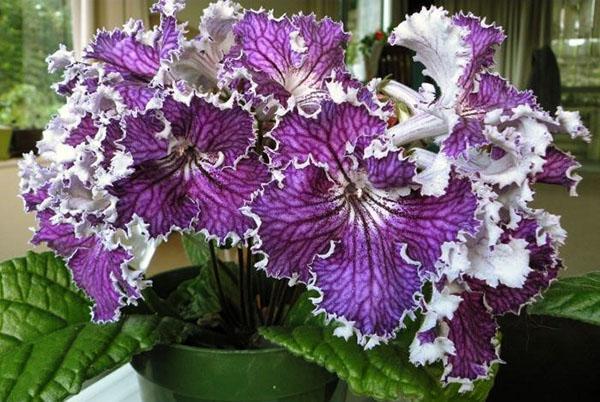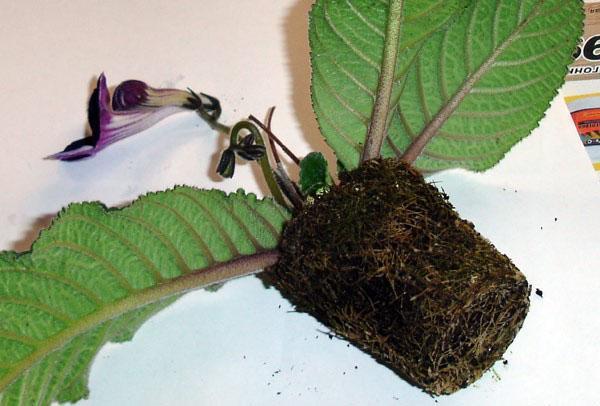Simple care and growing of streptocarp at home
 The beauty of the hybrid forms of streptocarpus is comparable to orchids subtlety and sophistication of inflorescences. Care and cultivation of streptocarpus will not cause difficulties even for a novice florist. Bright wrinkled lanceolate leaves up to 30 cm long frame a riot of floral bouquet. The flowers are single gramophone on a long arrow, but they come out of each axil of leaves, bloom for a long time and soar over the pots, forcing you to admire yourself.
The beauty of the hybrid forms of streptocarpus is comparable to orchids subtlety and sophistication of inflorescences. Care and cultivation of streptocarpus will not cause difficulties even for a novice florist. Bright wrinkled lanceolate leaves up to 30 cm long frame a riot of floral bouquet. The flowers are single gramophone on a long arrow, but they come out of each axil of leaves, bloom for a long time and soar over the pots, forcing you to admire yourself.
Photo of streptocarpus with proper care at home

Air humidity of 60-70% will create comfortable conditions. A pallet with pebbles and moss will help. In winter, the flower will gain strength for flowering if it is kept at a temperature of 16-18 degrees, excluding feeding and reducing watering. A month and a half of rest is enough for the plant to recover. In addition, the flower needs determining factors:
- the right substrate;
- watering and fertilizing;
- transplant;
- reproduction.
Container and soil composition for streptocarpus
 A distinctive feature of good care for streptocarpus at home is the rapid growth of the bush. The cache-pot is required low, but wide. There must be drainage, the layer will be about 2 cm. The plant is transplanted at the end of winter and again after six months. The best transfer method is to transfer to a large container.
A distinctive feature of good care for streptocarpus at home is the rapid growth of the bush. The cache-pot is required low, but wide. There must be drainage, the layer will be about 2 cm. The plant is transplanted at the end of winter and again after six months. The best transfer method is to transfer to a large container.
The main condition is that the soil should not be compacted, remain light and breathable. Regular soil for seedlings must be diluted in half with sand or perlite, chopped moss, vermiculite
The plant can be grown in peat... Peat-based soil should always be moist. When this substrate dries, a monolith is formed. Any soil for indoor plants, even purchased ones, must be sterilized.
Watering and humidification mode
 Growing healthy streptocarpus and caring for them is associated with proper hydration of the plants. Watering through a drainage hole is considered normal. It is good to organize the moistening of the earth through the wick. In this case, the constant supply of capillary moisture makes the soil stably moist. When watering overhead, water must be poured along the walls of the pots, trying not to get on the leaves and flowers.
Growing healthy streptocarpus and caring for them is associated with proper hydration of the plants. Watering through a drainage hole is considered normal. It is good to organize the moistening of the earth through the wick. In this case, the constant supply of capillary moisture makes the soil stably moist. When watering overhead, water must be poured along the walls of the pots, trying not to get on the leaves and flowers.
Water streptocarpus with soft warm water. If the plant has dropped its leaves due to the drying out of the earth, elasticity will be restored, but the drooping flowers will have to be cut, they are lost.
Mist spraying is a favorite with streptocarpus, but water droplets on the leaves can lead to unsightly spots. For moisture, it is appropriate to keep the flower pot on a pallet with a humidifier. A saucer of water installed not far from the plant will also help.
Power Requirements
 A young, rapidly growing bush after breeding requires nitrogen fertilization. But they should be reduced in percentage when buds appear. Now streptocarpus needs phosphorus and potassium.Of the ready-made compositions for indoor plants, the fertilizer "New Ideal" is used first, later fertilizers are suitable for beautifully flowering plants of the "Super flowering", "Vialochka" series and the like. The plant is fertilized once a week, alternating between different compositions. During the rest period, feeding is not done.
A young, rapidly growing bush after breeding requires nitrogen fertilization. But they should be reduced in percentage when buds appear. Now streptocarpus needs phosphorus and potassium.Of the ready-made compositions for indoor plants, the fertilizer "New Ideal" is used first, later fertilizers are suitable for beautifully flowering plants of the "Super flowering", "Vialochka" series and the like. The plant is fertilized once a week, alternating between different compositions. During the rest period, feeding is not done.
It is better to halve the recommended fertilizer doses. If during this period the plant actively grows leaves, this is normal. A peduncle will appear from the axils of each leaf. Therefore, the lower leaves, in which the peduncle has already faded, must be removed, carefully cutting with a sharp knife. Watch a video on how to care for streptocarp and grow a spectacular bush.
Pests and diseases of streptocarpus
 Powdery mildew and gray rot can become diseases that affect the plant. If a section of a leaf seems to have been powdered with white dust, it is powdery mildew. Under the raid, sores will appear and the leaf will die. The disease spreads quickly and all house flowers are at risk. Therefore, you need to cut out the affected leaf and treat the plants with Topaz, this is a targeted fungicide.
Powdery mildew and gray rot can become diseases that affect the plant. If a section of a leaf seems to have been powdered with white dust, it is powdery mildew. Under the raid, sores will appear and the leaf will die. The disease spreads quickly and all house flowers are at risk. Therefore, you need to cut out the affected leaf and treat the plants with Topaz, this is a targeted fungicide.
No less formidable disease of streptocarpus is gray rot, covering all parts of the plant with a gray fluffy bloom. Such a plant must be washed under a warm shower and treated with a fungicide. if new lesions appear, repeat the treatment.
The conditions for fungal diseases are excessive watering, keeping in cold conditions, or vice versa, creating a greenhouse effect. It is necessary to bring the temperature and humidity back to normal, and the diseases will recede.
Of the insect pests, the spider mite is especially annoying to streptocarpus. It starts in dry air, spreads very quickly along the back of the leaf. Sucking out the juice, he envelops the leaf with cobwebs, in which numerous members of the colony swarm. As a result, the leaf is paler, turns yellow, dries out. To save a flower, it must be isolated and free from flowers. Three times in 7-10 days, treat with one of the insecticidal preparations. Spray the top layer of the earth too. At this time, it is necessary to strengthen control of the state of other plants. The pest is omnivorous.
Exactly the same operations are carried out if thrips is found.
Reproduction of streptocarpus
An important condition for the spread of culture is its ability to reproduce. The flower in question reproduces:
- dividing the bush;
- seeds;
- leaf blade.
The easiest breeding method is to divide the bush during transplantation. The bush flower expands due to the accretion of lateral formed bushes and is easily divided into parts. Due to the division, the bush is rejuvenated.
It is possible to grow streptocarpus from seeds at home. Very small seeds, dredged for sale. The sowing is superficial, but since the shell needs to be destroyed, the top layer of the earth must be moist. You can get new items with unexpected colors all year round. It takes 7 months from sowing to flowering. Seedlings need additional lighting in winter. More often, streptocarpus is propagated by a leaf.
Here, the property of all Gesneriaceae is used to regenerate the roots as part of the leaf plate. For reproduction, a healthy ripe leaf and a razor for cutting fragments are taken, as in the photo. Plant a stalk in a soaked peat tablet and wait for the result. Young shoots formed around the leaf are planted in separate cups.
There is the "Toaster" method, when only the central vein is removed from a whole sheet and longitudinal stripes are arranged in a mini-greenhouse, for example, a box from under a roll. We compact and spray the planting, further we continue to create dampness in the box. There will be a lot of children who need to be seated.
Simple care, easy breeding of streptocarpus is available even for beginners.